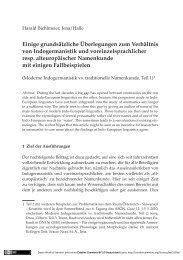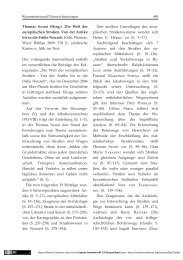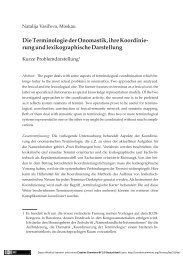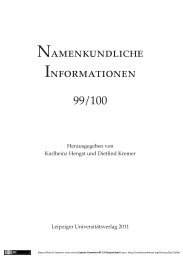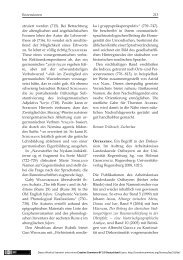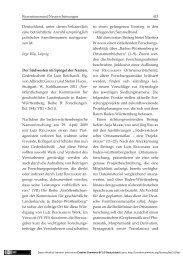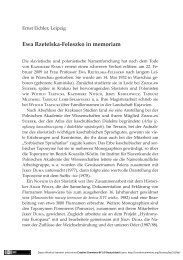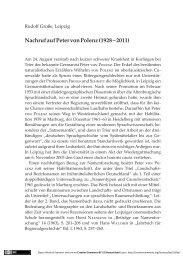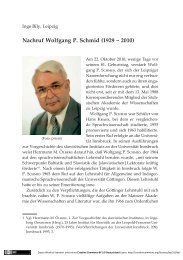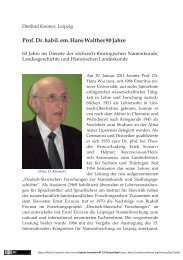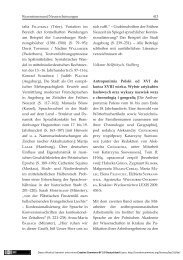Proper Names in the Light of Theoretical Onomastics
Proper Names in the Light of Theoretical Onomastics
Proper Names in the Light of Theoretical Onomastics
Create successful ePaper yourself
Turn your PDF publications into a flip-book with our unique Google optimized e-Paper software.
<strong>Proper</strong> <strong>Names</strong> In <strong>the</strong> <strong>Light</strong> <strong>of</strong> <strong>Theoretical</strong> <strong>Onomastics</strong>125V. Kohlheim make an orig<strong>in</strong>al methodological contribution to <strong>the</strong> development<strong>of</strong> particular personal names (Rufnamen) <strong>in</strong> a first nam<strong>in</strong>g system.And, similarly, W. Wenzel (2004, 705), who analyses <strong>in</strong> detail <strong>the</strong> historicaland social conditions lead<strong>in</strong>g to <strong>the</strong> <strong>in</strong>heritance and establishment <strong>of</strong> <strong>the</strong>written form <strong>of</strong> bynames (protosurnames), does not consider <strong>in</strong> what <strong>the</strong>transformation <strong>of</strong> <strong>the</strong> system relations between <strong>the</strong> Christian name andsurname <strong>in</strong> <strong>the</strong> transition from <strong>the</strong> first nam<strong>in</strong>g to b<strong>in</strong>ary nam<strong>in</strong>g systemlies and how this transformation is manifested or, <strong>in</strong> o<strong>the</strong>r words, whatled to <strong>the</strong> hierarchical transformation <strong>of</strong> <strong>the</strong>se two functional components(<strong>in</strong> detail, see chapter 2. 4).A textological method <strong>in</strong>troduced a deeper view <strong>of</strong> <strong>the</strong> position <strong>of</strong> <strong>the</strong>proper name <strong>in</strong> a microtext (compare, e. g. Harweg 1993; Werner 1989). Itis <strong>in</strong>terest<strong>in</strong>g to note that, <strong>in</strong> deepened textological contributions, <strong>the</strong> socalledproprial context P : P : P was not taken <strong>in</strong>to consideration althoughpragmatic supra-<strong>in</strong>dividual features can be abstracted, especially <strong>in</strong> proprialcontexts. R. Harweg analyses, from <strong>the</strong> aspect <strong>of</strong> its l<strong>in</strong>guistic status,<strong>the</strong> use <strong>of</strong> <strong>the</strong> Christian name as a bearer <strong>of</strong> sentence stress <strong>in</strong> a macrotextbut not as a functional component <strong>of</strong> an anthroponymic system (<strong>of</strong> a certa<strong>in</strong>subsystem).Up to <strong>the</strong> present, <strong>the</strong> analysis <strong>of</strong> isolated proper names obscures <strong>the</strong>problems associated with <strong>the</strong> content (mean<strong>in</strong>g) <strong>of</strong> a proper name. Onesidedunderstand<strong>in</strong>g <strong>of</strong> an onymic sign can hardly address this question.Perhaps, <strong>the</strong> above examples can serve to demonstrate <strong>the</strong> need for <strong>the</strong>non-conditional collaboration <strong>of</strong> <strong>the</strong> two methodological procedures: <strong>the</strong>analysis <strong>of</strong> a concrete (and as diverse as possible) material must be l<strong>in</strong>kedwith an effort to decipher <strong>the</strong> <strong>in</strong>ternal system relations <strong>in</strong> <strong>the</strong> organisationand social function<strong>in</strong>g <strong>of</strong> onymic systems.A note on term<strong>in</strong>ology.Anthroponymy as a systematic structured and standardised whole andas an open set <strong>of</strong> names which act <strong>in</strong> social communication is two <strong>in</strong>terrelatedvariables; <strong>the</strong> first belongs to “langue” and <strong>the</strong> second to speech andtext. Therefore, it is reasonable to dist<strong>in</strong>guish between <strong>the</strong>m:An anthroponymic system as a phenomenon <strong>of</strong> deep structure (langue)can have <strong>the</strong> character <strong>of</strong> a first nam<strong>in</strong>g structure when, hierarchically,<strong>the</strong> Christian name is <strong>the</strong> basic component; when <strong>the</strong> basic component is<strong>the</strong> surname <strong>the</strong>n <strong>the</strong> b<strong>in</strong>ary nam<strong>in</strong>g system is <strong>in</strong>volved; a special typeis a name with an obligatory patronymic and (hereditary) surname. For



